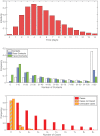Efficacy of contact tracing for the containment of the 2019 novel coronavirus (COVID-19)
- PMID: 32576605
- PMCID: PMC7307459
- DOI: 10.1136/jech-2020-214051
Efficacy of contact tracing for the containment of the 2019 novel coronavirus (COVID-19)
Abstract
Objective: Contact tracing is a central public health response to infectious disease outbreaks, especially in the early stages of an outbreak when specific treatments are limited. Importation of novel coronavirus (COVID-19) from China and elsewhere into the UK highlights the need to understand the impact of contact tracing as a control measure.
Design: Detailed survey information on social encounters from over 5800 respondents is coupled to predictive models of contact tracing and control. This is used to investigate the likely efficacy of contact tracing and the distribution of secondary cases that may go untraced.
Results: Taking recent estimates for COVID-19 transmission we predict that under effective contact tracing less than 1 in 6 cases will generate any subsequent untraced infections, although this comes at a high logistical burden with an average of 36 individuals traced per case. Changes to the definition of a close contact can reduce this burden, but with increased risk of untraced cases; we find that tracing using a contact definition requiring more than 4 hours of contact is unlikely to control spread.
Conclusions: The current contact tracing strategy within the UK is likely to identify a sufficient proportion of infected individuals such that subsequent spread could be prevented, although the ultimate success will depend on the rapid detection of cases and isolation of contacts. Given the burden of tracing a large number of contacts to find new cases, there is the potential the system could be overwhelmed if imports of infection occur at a rapid rate.
Keywords: Disease modeling; Epidemiology; communicable diseases; public health policy.
© Author(s) (or their employer(s)) 2020. Re-use permitted under CC BY. Published by BMJ.
Conflict of interest statement
Competing interests: None declared.
Figures




References
-
- McLean E, Pebody RG, Campbell C, et al. . Pandemic (H1N1) 2009 influenza in the UK: clinical and epidemiological findings from the first few hundred (FF100) cases. Epidemiol Infect 2010;138:1531–41. - PubMed
MeSH terms
Grants and funding
LinkOut - more resources
Full Text Sources
Medical
